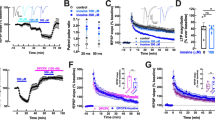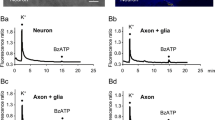Abstract
Adenosine is a neuromodulator known to inhibit the synaptic release of neurotransmitters, e.g., glutamate, and to hyperpolarize postsynaptic neurons. The release of adenosine is markedly enhanced under ischemic conditions. It may then act as an endogenous neuroprotectant against cerebral ischemia and excitotoxic neuronal damage. The mechanisms by which adenosine is released from nervous tissue are not fully known, particularly in the immature brain. We now characterized the release of [3H]adenosine from hippocampal slices from developing (7-day-old) and adult (3-month-old) mice using a superfusion system. The properties of the release differed only partially in the immature and mature hippocampus. The K+-evoked release was Ca2+ and Na+ dependent. Anion channels were also involved. Ionotropic glutamate receptor agonists potentiated the release in a receptor-mediated manner. Activation of metabotropic glutamate receptors enhanced the release in developing mice, with group II receptors alone being effective. The evoked adenosine release apparently provides neuroprotective effects against excitotoxicity under cell-damaging conditions. Taurine had no effect on adenosine release in adult mice, but depressed the release concentration dependently in the immature hippocampus.
Similar content being viewed by others
REFERENCES
Cunha, R. A. 2001. Adenosine as a neuromodulator and as a homeostatic regulator in the nervous system: Different roles, different sources and different receptors. Neurochem. Int. 38:107-125.
Latini, S. and Pedata, F. 2001. Adenosine in the central nervous system: Release mechanisms and extracellular concentrations. J. Neurochem. 79:463-484.
Haas, H. L. and Greene, R. W. 1988. Endogenous adenosine inhibits hippocampal CA1 neurones: Further evidence from extraand intracellular recording. Naunyn Schmiedeberg's Arch. Pharmacol. 337:561-565.
Psarropoulou, C., Kostopoulos, G., and Haas, H. L. 1990. An electrophysiological study of the ontogenesis of adenosine receptors in the CA1 area of rat hippocampus. Dev. Brain Res. 55:147-150.
Daval, J.-L., Werck, M. C., Nehlig, A., and Pereira de Vasconcelos, A. 1991. Quantitative autoradiographic study of the postnatal development of adenosine A1 receptors and their coupling to G proteins in the rat brain. Neuroscience 40:841-851.
Hagberg, H., Andersson, P., Lazarewicz, J., Jacobson, I., Butcher, S., and Sandberg, M. 1987. Extracellular adenosine, inosine, hypoxanthine, and xanthine in relation to tissue nucleotides and purines in rat striatum during transient ischemia. J. Neurochem. 49:227-231.
Phillis, J. W., Walter, G. A., O'Regan, M. H., and Stair, R. E. 1987. Increases in cerebral cortical perfusate adenosine and inosine concentrations during hypoxia and ischemia. J. Cereb. Blood Flow Metab. 7:679-686.
Rudolphi, K. A., Schubert, P., Parkinson, F. E., and Fredholm, B. B. 1992. Adenosine and brain ischemia. Cerebrovasc. Brain Metab. Rev. 4:346-369.
Dragunow, M. and Faull, R. L. 1988. Neuroprotective effects of adenosine. Trends Pharmacol. Sci. 9:193-194.
Deckert, J. and Gleiter, C. H. 1994. Adenosine: An endogenous neuroprotective metabolite and neuromodulator. J. Neural Transm. 43(Suppl.):23-31.
Saransaari, P. and Oja, S. S. 2000. Taurine and neural cell damage. Amino Acids 19:509-526.
Kontro, P. and Oja, S. S. 1987. Taurine and GABA release from mouse cerebral cortex slices: Potassium stimulation releases more taurine than GABA from developing brain. Dev. Brain Res. 37:277-291.
Huxtable, R. J. 1992. The physiological actions of taurine. Physiol. Rev. 72:101-163.
Sturman, J. A. 1993. Taurine in development. Physiol. Rev. 73:119-147.
Bouchard, R. and Fedida, D. 1995. Closed-and open-state binding of 4-aminopyridine to the cloned human potassium channel Kv1.5. J. Pharmacol. Exp. Ther. 275:864-876.
Doble, A. 1996. The pharmacology and mechanism of action of riluzole. Neurology 47:S233-S241.
Hamill, O. P. and McBride, D. W. Jr. 1996. The pharmacology of mechanogated membrane ion channels. Pharmacol. Rev. 48: 231-252.
Saransaari, P. and Oja, S. S. 1994. Taurine release from mouse hippocampal slices: Effects of glutamatergic substances and hypoxia. Adv. Exp. Med. Biol. 359:279-287.
Hoehn, K. and White, T. D. 1990. Role of excitatory amino acid receptors in K1-and glutamate-evoked release of endogenous adenosine from rat cortical slices. J Neurochem. 54:256-265.
Craig, C. G. and White, T. D. 1993. N-Methyl-D-aspartate-and non-N-methyl-D-aspartate-evoked adenosine release from rat cortical slices: Distinct purinergic sources and mechanisms of release. J. Neurochem. 60:1073-1080.
Latini, S., Pedata, F., and Pepeu, G. 1997. The contribution of different types of calcium channels to electrically-evoked adenosine release from rat hippocampal slices. Naunyn Schmiedeberg's Arch. Pharmacol. 355:250-255.
Hoehn, K. and White, T. D. 1990. Glutamate-evoked release of endogenous adenosine from rat cortical synaptosomes is mediated by glutamate uptake and not by receptors. J. Neurochem. 54:1716-1724.
Chen, Y., Graham, D. I., and Stone, T. W. 1992. Release of endogenous adenosine and its metabolites by the activation of NMDA receptors in the rat hippocampus in vivo. Br. J. Pharmacol. 106:632-638.
Korpi, E. R. and Oja, S. S. 1983. Characteristics of taurine release from cerebral cortex slices induced by sodium-deficient media. Brain Res. 289:197-204.
Parkinson, F. E., Rudolphi, K. A., and Fredholm, B. B. 1994. Propentofylline: A nucleoside transport inhibitor with neuro-protective effects in cerebral ischemia. Gen. Pharmacol. 25:1053-1058.
Sweeney, M. I. 1996. Adenosine release and uptake in cerebellar granule neurons both occur via an equilibrative nucleoside carrier that is modulated by G proteins. J. Neurochem. 67: 81-88.
Oja, S. S. and Korpi, E. R. 1985. Amino acid transport. Pages 311-337, in Lajtha A. (ed.) Handbook of Neurochemistry, Vol. 5, 2nd ed. Plenum Press, New York.
Schousboe, A., Morán, J., and Pasantes-Morales, H. 1990. Potassium-stimulated release of taurine from cultured cerebellar granule cells is associated with cell swelling. J. Neurosci. Res. 27:71-77.
Saransaari, P. and Oja, S. S. 1999. Mechanisms of D-aspartate release under ischemic conditions in mouse hippocampal slices. Neurochem. Res. 24:1009-1016.
Delaney, S. M., Shepel, P. N., and Geiger, J. D. 1998. Levels of endogenous adenosine in rat striatum. I. Regulation by ionotropic glutamate receptors, nitric oxide and free radicals. J. Pharmacol. Exp. Ther. 285:561-567.
Craig, C. G. and White, T. D. 1993. NMDA-evoked adenosine release from rat cortex does not require the intermediate formation of nitric oxide. Neurosci. Lett. 159:167-169.
Craig, C. G., Temple, S. D., and White, T. D. 1994. Is cyclic AMP involved in excitatory amino acid-evoked adenosine release from rat cortical slices. Eur. J. Pharmacol. 269:79-85.
Szatkowski, M. and Attwell, D. 1994. Triggering and execution of neuronal death in brain ischemia: Two phases of glutamate release by different mechanisms. Trends Neurosci. 17:359-365.
Pin, J.-P. and Duvoisin, R. 1995. The metabotropic glutamate receptors: Structure and functions. Neuropharmacology 34:1-26.
Conn, P. J. and Pin, J.-P. 1997. Pharmacology and functions of metabotropic glutamate receptors. Annu. Rev. Pharmacol. Toxicol. 37:205-237.
Riedel, G. 1996. Function of metabotropic glutamate receptors in learning and memory. Trends Neurosci. 19:219-224.
Uyama, Y., Ishida, M., and Shinozaki, H., 1997. DCG-IV a potent metabotropic glutamate receptor agonist, as an NMDA receptor agonist in the rat cortical slice. Brain Res. 752:327-330.
Sánchez-Prieto, J., Budd, D. C., Herrero, I., Vázquez, E., and Nicholls, D. G., 1996. Presynaptic receptors and the control of glutamate exocytosis. Trends Neurosci. 19:235-239.
Cozzi, A., Attucci, S., Peruginelli, F., Marinozzi, M., Luneia, R., Pellicciari, R., and Moroni, F. 1997. Type 2 metabotropic glutamate (mGlu) receptors tonically inhibit transmitter release in rat caudate nucleus: In vivo studies with (2S,18S,28S,38R)-2-(28-carboxy-38-phenylcyclopropyl)glycine, a new potent and selective antagonist. Eur. J. Neurosci. 9:1350-1355.
Bruno, V., Battaglia, G., Copani, A., Giffard, R. G., Raciti, G., Shinozaki, H., and Nicoletti, F. 1995. Activation of class II or III metabotropic glutamate receptors protects cultured cortical neurons against excitotoxic degeneration. Eur. J. Neurosci. 7: 1906-1913.
McDonald, J. W. and Johnston, M. V. 1990. Physiological and pathophysiological roles of excitatory amino acids during central nervous system development. Brain Res. Rev. 15:41-70.
Le Grevés, P., Hoogendoorn, K., Synnergren, B., Meyerson, B., and Nyberg, F. 1996. The relationship between the NMDA receptor NR1 subunit mRNA and [3H]MK-801 binding in the embryonic and early postnatal rat CNS. Neurosci. Res. Commun. 19:145-152.
Pokorny, J. and Yamamoto, T. 1981. Postnatal ontogenesis of hippocampal CA1 area in rats. I. Development of dendritic arborization in pyramidal neurons. Brain Res. Bull. 7:113-120.
Miller, L. P., Johnston, A. E., Gelhard, R. E., and Insel T. R. 1990. The ontogeny of excitatory amino acid receptors in the rat forebrain. II. Kainic acid receptors. Neuroscience 35:45-51.
Cunha, R. A., Johansson, B., Van der Ploeg, I., Sebastiao, A. M., Ribeiro, J. A., and Fredholm, B. B. 1994. Evidence for functionally important adenosine A2A receptors in the rat hippocampus. Brain Res. 649:208-216.
Sebastiao, A. M., Stone, T. W., and Ribeiro, J. A. 1990. The inhibitory adenosine receptor at the neuromuscular junction and hippocampus of the rat: Antagonism by 1,3,8-substituted xanthines. Br. J. Pharmacol. 101:453-459.
Greene, R. W. and Haas, H. L. 1991. The electrophysiology of adenosine in the mammalian central nervous system. Prog. Neurobiol. 36:329-341.
Sebastiao, A. M. and Ribeiro, J. A. 1992. Evidence for the presence of excitatory A2 adenosine receptors in the rat hippocampus. Neurosci. Lett. 138:41-44.
Fredholm, B. B. and Dunwiddie, T. V. 1988. How does adenosine inhibit transmitter release? Trends Pharmacol. Sci. 9:130-134.
Ferre, S., Rubio, A., and Fuxe, K. 1991. Stimulation of adenosine A2 receptors induces catalepsy. Neurosci. Lett. 130:162-164.
Kurokawa, M., Kirk, I. P., Kirkpatrick, K. A., Kase, H., and Richardson, P. J. 1994. Inhibition by KF17837 of adenosine A2A receptor-mediated modulation of striatal GABA and ACh release. Br. J. Pharmacol. 113:43-48.
Corsi, C., Melani, A., Bianchi, L., Pepeu, G., and Pedata, F. 1999. Striatal A2A adenosine receptors differentially regulate spontaneous and K1-evoked glutamate release in vivo in young and aged rats. Neuroreport 10:687-691.
Greiger, J. D., LaBella, F. S., and Nagy, J. I. 1984. Ontogenesis of adenosine receptors in the central nervous system of the rat. Brain Res. 315:97-104.
Johansson, B., Georgiev, V., and Fredholm, B. B. 1997. Distribution and postnatal ontogeny of adenosine A2A receptors in rat brain: Comparison with dopamine receptors. Neuroscience 80:1187-1207.
Morgan, P. F., Deckert, J., Nakajima, T., Daval, J. L., and Marangos, P. J. 1990. Late ontogenetic development of adenosine A1 receptor coupling to associated G-proteins in guinea pig cerebellum but not forebrain. Mol. Cell. Biol. 921:169-176.
Saransaari, P. and Oja, S. S. 1999. Characteristics of ischemiainduced taurine release in the developing mouse hippocampus. Neuroscience 94:949-954.
Kontro, P., Marnela, K.-M., and Oja, S. S. 1980. Free amino acids in the synaptosome and synaptic vesicle fractions of different bovine brain areas. Brain Res. 184:129-141.
Magnusson, K. R., Clements, J. R., Wu, J.-Y., and Beitz, A. J. 1989. Colocalization of taurine-and cysteine sulfinic acid decarboxylase-like immunoreactivity in the hippocampus of the rat. Synapse 4:55-69.
Saransaari, P. and Oja, S. S. 1998. Release of endogenous glutamate, aspartate, GABA and taurine from hippocampal slices from adult and developing mice under cell-damaging conditions. Neurochem. Res. 23:563-570.
Taber, K. H., Lin, C.-T., Liu, J.-W., Thalmann, R., and Wu, J.-Y. 1986. Taurine in hippocampus: localization and postsynaptic action. Brain Res. 386:113-121.
French, E. D., Vezzani, A., Whetsell, W. O. Jr., and Schwarcz, R. 1986. Antiexcitotoxic actions of taurine in the rat hippocampus studied in vivo and in vitro. Adv. Exp. Med. Biol. 203:349-362.
Trenkner, E. 1990. The role of taurine and glutamate during early postnatal cerebellar development of normal and weaver mutant mice. Adv. Exp. Med. Biol. 268:239-244.
Schurr, A., Tseng, M. T., West, C. A., and Rigor, B. M. 1987. Taurine improves the recovery of neuronal function following cerebral hypoxia: An in vitro study. Life Sci. 40:2059-2066.
Oja, S. S. and Kontro, P. 1983. Free amino acids in epilepsy: possible role of taurine. Acta Neurol. Scand. 67(Suppl. 93):5-20.
Saransaari, P. and Oja, S. S. 2000. Modulation of the ischemiainduced taurine release by adenosine receptors in the developing and adult mouse hippocampus. Neuroscience 97:425-430.
Saransaari, P. and Oja, S. S. 2002. Characterization of Nmethyl-D-aspartate-evoked taurine release in the developing and adult mouse hippocampus. Amino Acids, in press.
Author information
Authors and Affiliations
Rights and permissions
About this article
Cite this article
Saransaari, P., Oja, S.S. Mechanisms of Adenosine Release in the Developing and Adult Mouse Hippocampus. Neurochem Res 27, 911–918 (2002). https://doi.org/10.1023/A:1020343631833
Issue Date:
DOI: https://doi.org/10.1023/A:1020343631833




